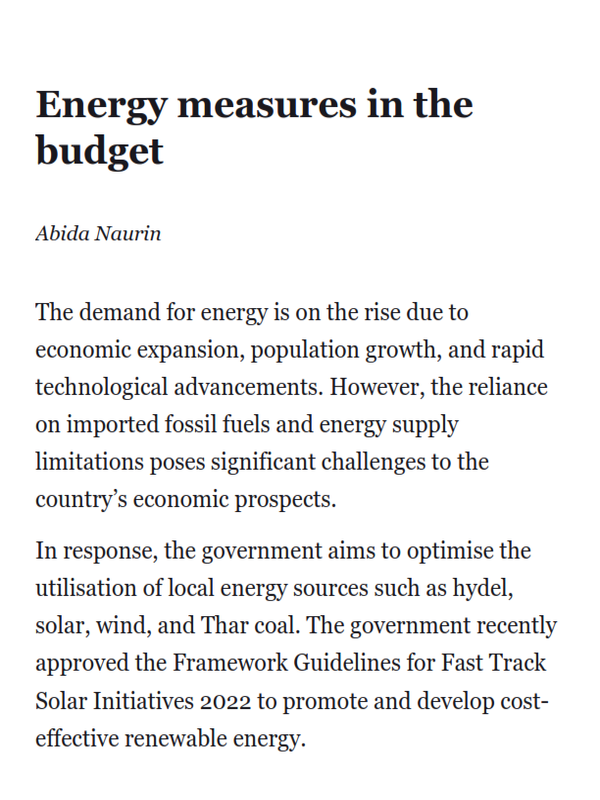Energy measures in the budget
The demand for energy is on the rise due to economic expansion, population growth, and rapid technological advancements. However, the reliance on imported fossil fuels and energy supply limitations poses significant challenges to the country’s economic prospects.
In response, the government aims to optimise the utilisation of local energy sources such as hydel, solar, wind, and Thar coal. The government recently approved the Framework Guidelines for Fast Track Solar Initiatives 2022 to promote and develop cost-effective renewable energy.
This framework primarily focuses on substituting expensive imported fossil fuels with solar photovoltaic (PV) energy, implementing solar PV generation on 11kV feeders, and solarising public buildings.
During the current fiscal year (2022-23), the addition of three Thar coal-based power plants has increased the total installed capacity to 3,300MW. Additionally, there are six nuclear power plants with a combined installed capacity of 3,560MW.
A critical review is required to evaluate the effectiveness of government policies and explore potential challenges and opportunities
As of July-March FY23, the total installed capacity and electricity generation reached 41,050MW and 94,121GWh, respectively. The distribution of installed capacity among hydel, nuclear, renewable, and thermal sources is 25.8 per cent, 8.7pc, 6.8pc, and 58.7pc, respectively.
Likewise, electricity generation shares were 28.6pc, 21pc, 4.2pc, and 46.2pc for hydel, nuclear, renewables, and thermal sources, respectively. (Pakistan Economic Survey, 2022-23).
In terms of electricity consumption, the household sector accounted for 47.2pc of the total, followed by the industrial sector at 28pc, agriculture at 8.1pc, and commercial at 7.8pc. The total demand for petroleum products saw a decline of 21.9pc, reaching 13.1 million tonnes in July-March FY23.
The transport sector alone consumed about 78.5pc of petroleum products. Notably, there was a notable decrease in the demand for motor spirit, high-speed diesel, and furnace oil, which accounted for approximately 95pc of the total demand.
To meet this demand, petroleum products and crude oil imports amounted to 6,118.3 thousand metric tonnes and 5,858.4 thousand tonnes, respectively.
Furthermore, natural gas consumption during July-March FY23 was around 3,267m cubic feet per day (MMCFD), including 626 MMCFD of re-gasified liquefied natural gas (RLNG). Lastly, the power, brick kilns, and cement/other sectors consumed 47.3pc, 21.5pc, and 31.1pc of the total coal consumption, amounting to 15,416.5 thousand tonnes.
A budget of Rs30 billion has been set out for the solar energy conversion of 50,000 solar tube wells under this framework. The government also aims to reduce reliance on energy imports by enhancing dependency on renewable sources.
Batteries, solar panels, and inverters’ raw materials will be free from customs taxes (Budget document 2023-24). As Pakistan’s electricity generating capacity surpasses 41,000MW, Rs107bn has been set aside to improve the effectiveness of power transmission.
To support the Pakistan-Tajikistan 500kV power project, Rs16bn has been allocated to expand bilateral energy cooperation and Rs12bn for the Jamshoro coal project.
During the fiscal year 2023–24, mega transmission projects like CASA–1000 (Rs16.1bn) and the transmission sector is anticipated to have 3,750 MVA additional capacity on the 500kV grid and 6,900 MVA more capacity on the 220kV grid by the end of June 2024.
The transmission lines will be extended by 522km, and on the 220kV level, by 668km. Dasu Evacuation (Rs5.67bn) and Suki Kinari Evacuation (Rs13.8bn) are allocated in the current budget. In addition, Rs7.27bn has been allotted for eight projects to deliver electricity to Special Economic Zones.
The Public Sector Development Programme 2023–24 includes major distribution projects like Advanced Metering Infrastructure for Islamabad Electric Supply Company, which is worth Rs3bn. The distribution sector investments will electrify 6,985 villages, creating 1.4m new customers for distribution companies (Disco).
Since crude oil and refined petroleum products make up most of the energy industry, the Bonded Bulk Storage Policy for POL (petroleum) Products will be implemented to address the problem of supply chain disruption.
Mohmand Dam, the Diamer Bhasha Dam, and the Dasu Hydropower Project will have a budget of Rs10.5bn, Rs20bn and Rs59bn, respectively, in FY24. These initiatives seek to produce power at a reasonable price while also supplying water to the agriculture sector.
However, nothing in the budget addressed ways to reduce theft, line loss, or circular debt. Diversification of energy sources, reduction of reliance on imported fuels, and investment in renewable energy infrastructure are key to ensuring long-term energy security and economic stability.
A research report on “PIDE’s Charter of Economy” by the Pakistan Institute of Development Economics (PIDE) stated that smart metering technologies should be used to transition the power supply to a pre-paid basis.
While contracts should be issued based on best achievements, the government should also carefully consider leasing out the challenging retail districts to the private sector for a certain length of time. Reduce the role of the government in setting tariffs and state-owned discos.
Further, to reduce theft, first off, retail management should be outsourced. Next, high-quality measuring tools should be installed to address the problem of Unaccounted for Gas (UFG). Second, term profitability should be eliminated since it allows gas distribution corporations to make money when operational efficiency should be the source of such profits.
Thirdly, it is necessary to create a single consumer tariff based on cost-of-service. Fourth, review long-term LNG contracts to release some of the gas volumes and allow third parties (third-party access) to acquire the gas on a short-term basis or the open market.
Lastly, attain price convergence between RLNG and piped indigenous gas. A more critical review should delve into the implications of the figures, evaluate the effectiveness of government policies, and explore the potential challenges and opportunities in the energy sector.
The writer is a Research Fellow at PIDE, Islamabad.
Twitter: @abida_15
Published in Dawn, The Business and Finance Weekly, July 3rd, 2023




